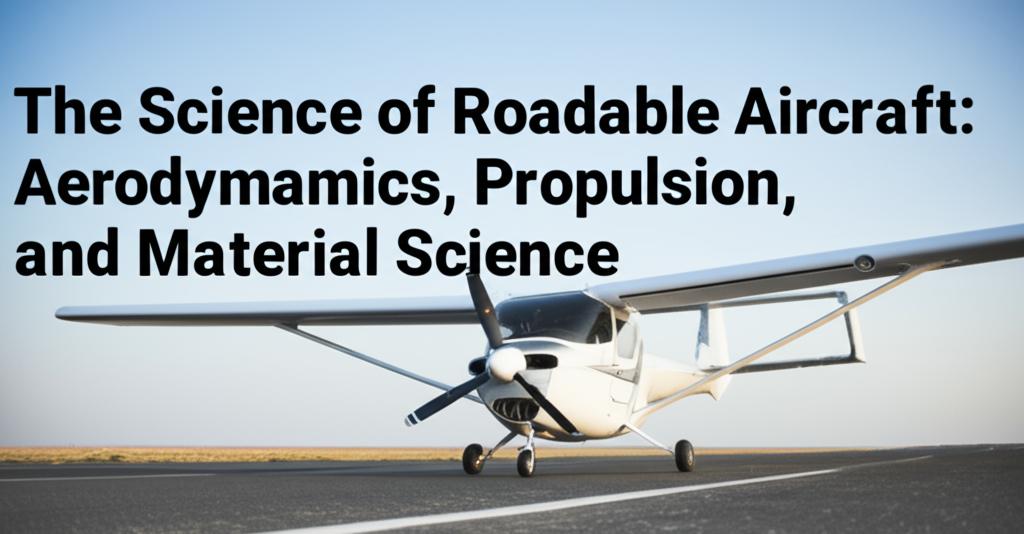The dream of a vehicle that can seamlessly transition from road to sky is rapidly moving from science fiction to reality. The development of roadable aircraft, also known as flying cars, stands at the intersection of automotive and aerospace engineering, presenting unique challenges and opportunities in aerodynamics, propulsion, and materials science.
Aerodynamics: A Balancing ActThe aerodynamic design of a roadable aircraft is a complex balancing act. The vehicle must be optimized for both ground travel and flight. This means designers must consider:
- Lift and Drag: Efficiently generating lift for flight while minimizing drag in both modes is crucial. This involves carefully shaping the fuselage, wings, and control surfaces. Many designs incorporate foldable or retractable wings to reduce drag and conform to road vehicle dimensions.
- Stability and Control: The aircraft must be stable and controllable in both ground and air operations. This necessitates sophisticated control systems that can adapt to the different aerodynamic forces at play. For Vertical Takeoff and Landing (VTOL) capable aircraft, this includes managing the transition from vertical to horizontal flight.
- Airflow Management: The interaction of air with the vehicle's surfaces dictates its performance. Understanding and optimizing airflow is critical for everything from wing shape to the placement of propulsion systems. Concepts like Bernoulli's Principle and Newton's Laws of Motion are fundamental to these designs.
- VTOL and STOL Capabilities: Many modern roadable aircraft designs incorporate VTOL (Vertical Takeoff and Landing) or STOL (Short Takeoff and Landing) capabilities. This significantly impacts aerodynamic design, often requiring innovative solutions like tilting rotors, ducted fans, or cyclorotors to manage airflow for vertical lift and transition to forward flight.
Propulsion systems for roadable aircraft must be lightweight, powerful, efficient, and increasingly, sustainable. Key advancements and considerations include:
- Electric and Hybrid-Electric Systems: The push for sustainability is driving the adoption of electric and hybrid-electric propulsion. Electric motors offer quiet operation and zero emissions during flight, which is crucial for urban air mobility. Hybrid systems, combining batteries with traditional combustion engines or fuel cells, can extend range and provide power redundancy.
- Distributed Electric Propulsion (DEP): DEP involves using multiple electric motors distributed across the airframe. This offers improved safety through redundancy, quieter operation, and enhanced maneuverability.
- Innovative Propulsion Technologies: Companies are exploring novel propulsion solutions. CycloTech, for instance, is developing CycloRotors, a system based on the Voith-Schneider principle, offering 360-degree thrust vectoring for precise control and maneuverability, even enabling mid-air braking. Ducted electric vectored thrust (DEVT) systems, as seen in concepts like the Lilium Jet, are another area of innovation.
- Energy Storage: Battery technology remains a significant hurdle. Current lithium-ion batteries have limitations in energy density, impacting range and payload. Ongoing research into next-generation batteries, such as lithium-sulfur, and advancements in power efficiency are critical for the viability of electric roadable aircraft. Hybrid solutions often use a range extender, like a small internal combustion engine, to charge batteries for longer flights or provide reserve power.
- Noise Reduction: For urban operations, minimizing noise pollution is paramount. Electric propulsion inherently offers a quieter solution than traditional combustion engines, but aerodynamic noise from rotors and wings also needs to be managed through careful design.
The materials used in roadable aircraft must be exceptionally lightweight yet incredibly strong to meet the demands of both road travel and flight. This has spurred innovation in:
- Advanced Composites: Carbon fiber and other advanced composite materials are essential. They offer high strength-to-weight ratios, crucial for reducing overall vehicle weight, which in turn improves fuel efficiency, range, and payload capacity.
- Lightweight Alloys: Specialized aluminum and titanium alloys continue to play a role, offering a balance of strength, durability, and ease of manufacturing for certain components.
- Multi-Functional Materials: Research is ongoing into materials that can serve multiple purposes, such as structural components that also have embedded sensors or energy storage capabilities.
- Durability and Maintenance: Materials must also be durable enough to withstand the rigors of both ground and air operations, including varying weather conditions, and allow for practical maintenance schedules. The structural integrity of the airframe is paramount for safety.
The development of roadable aircraft is a multidisciplinary endeavor. Advances in artificial intelligence are enhancing autonomous navigation and control systems, making these vehicles potentially safer and easier to operate. The integration of these aircraft into existing transportation infrastructure, including developments in air traffic management for urban air mobility (UAM), is another critical area of focus.
While significant technical challenges remain, particularly in battery technology, regulatory frameworks, and public acceptance, the science underpinning roadable aircraft is advancing at a remarkable pace. The coming years are expected to see further breakthroughs as these innovative vehicles move closer to becoming a common sight in our skies and on our roads.

